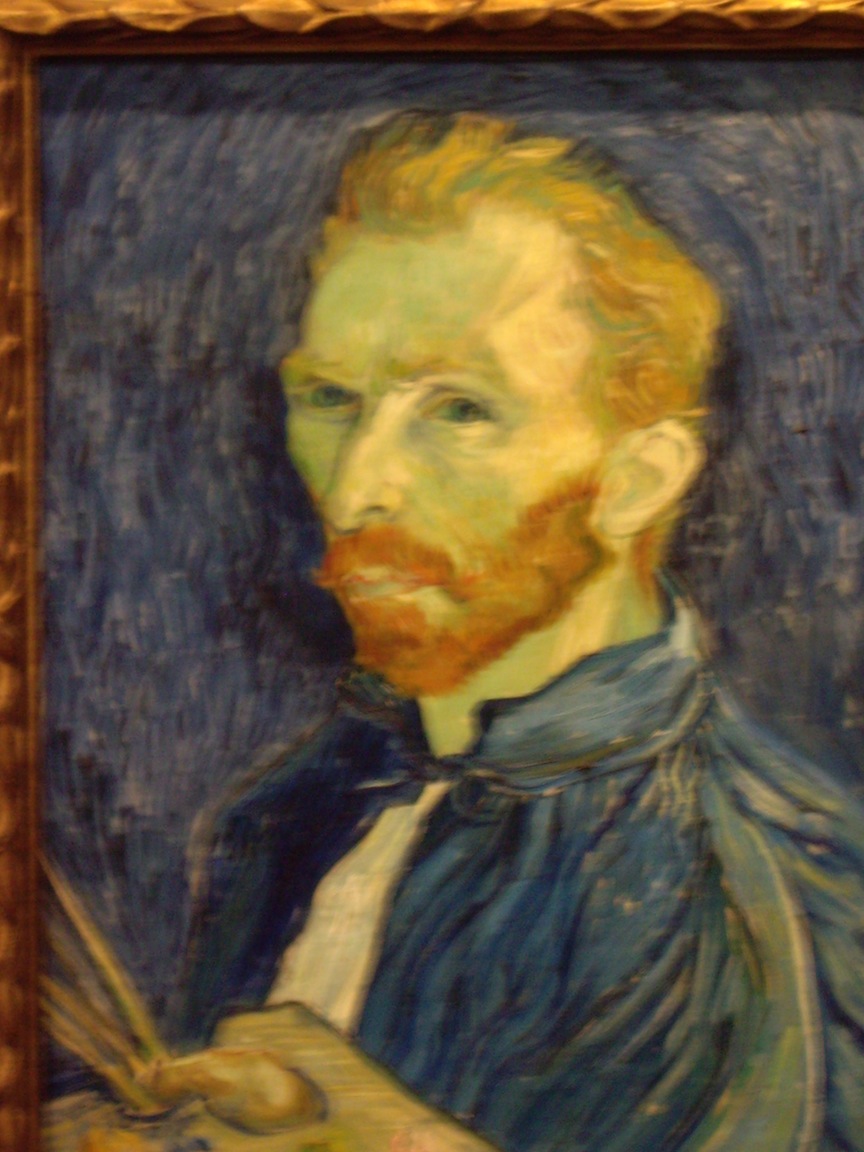
Visual Thinking, by Rudolph Arnheim.
"Groundbreaking when first published in 1969, this book is now of even greater relevance to make the reader aware of the need to educate the visual sense, a matter so harmfully neglected in the present system."
-- Peter Selz, author of Nathan Oliveira
In 1997, Philip Yenawine describes visual literacy as
"…the ability to find meaning in imagery. It involves a set of skills ranging from simple identification (naming what one sees) to complex interpretation on contextual, metaphoric and philosophical levels. Many aspects of cognition are called upon, such as personal association, questioning, speculating, analyzing, fact-finding, and categorizing. Objective understanding is the premise of much of this literacy, but subjective and affective aspects of knowing are equally important."
Vincent van Gogh, self portrait, (one of over thirty) Oil on Canvas, 1889, National Gallery of Art
| The painting and the photograph: two opposed or complementary art forms? | |
|---|---|
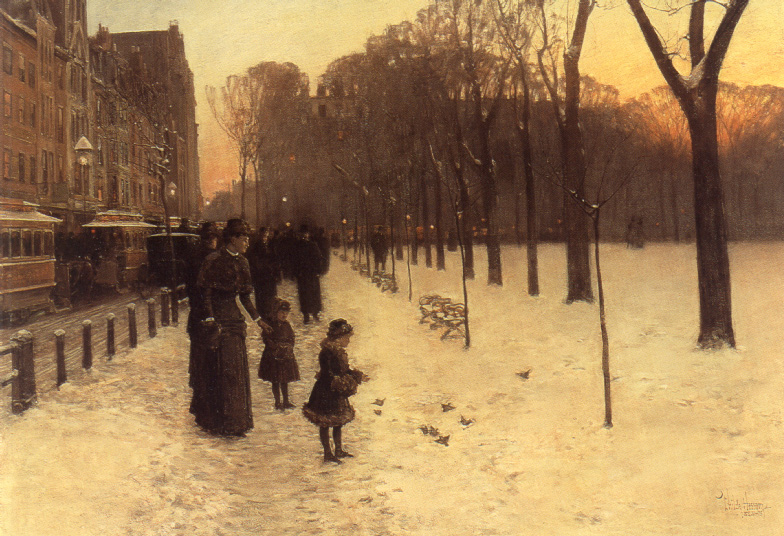 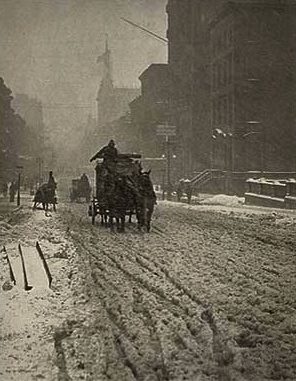 |
|
| Childe Hassam, Boston Common (1885-86) & Alfred Stieglitz Winter on Fifth Avenue, (1893) New York from about the same decade. | |
|
"The 'objective eye' of the photographic camera and impersonal traces of light on photographic emulsion were, virtually from the public announcements of the new medium in France and England in 1839, hailed as powerful tools in scientific recording." Newer technique of representation. |
|
| photographs | |
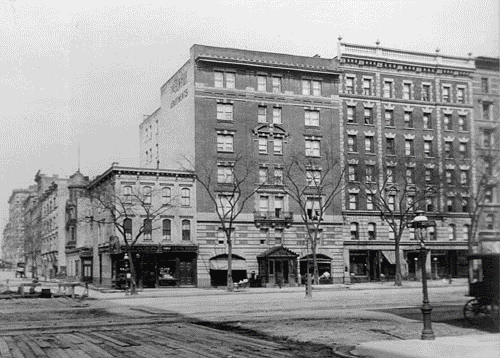 |
 |
Photographs can capture changes. |
The photographs of tracks in a vacuum tube revealed subatomic particles. |
Older means of representing people, objects, & settings was oil painting.
|
|
Three hundred years separate these two innovative painters. |
|
| Paintings of what the artist conceives as they paint. | |
 |
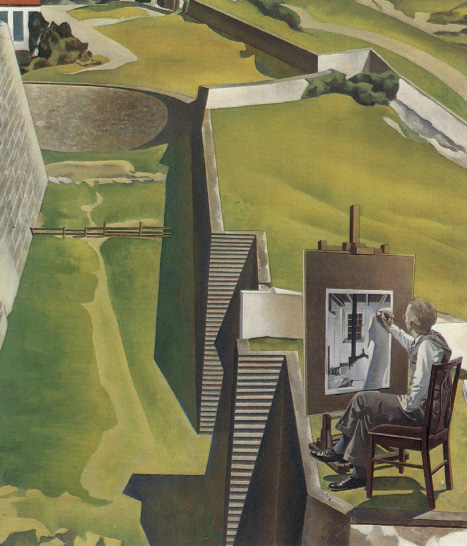 |
| Johannes, Jan or Johan Vermeer, The Artist's Studio, 1640s-66. | George Sheeler, 1943. |
| "Vermeer shows us to what extent a lesson learned is one step in his representation of the absolute." 1 | "Nature, as depicted here, is surreal, with inexplicable discrepancies of scale and perspective." |
| The Art Institute of Chicago. | |
| Both paintings show the artist painting a subject; because of that portrayal of the artist on the canvas looking at the objects he is painting it can be said that both reveal a reflective look at the practice of painting; this seems hard to miss. | |
Notes on scale and size | How to cite art works
Scale is a related set of measures of a things' dimensions and use of scale implies the appreciation of how volume & surface area change in proportion to one another as a standard system used to measure something in comparison to another thing.
Human scale of buildings from the 19th century in Martha's Vineyard.
What do we value?
Rene Dubos in 1972 called for "a new definition of progress, based on better knowledge of nature and on a willingness to change our ways of life accordingly," and Ian McHarg, urban planner, insisted just three years earlier that "The world is abundant, we require only a deference born of understanding to fulfill man's promise. . . . He must become the steward of the biosphere. To do this he must design with nature," and we may think of these ideas as planetary housekeeping's two commandments.
Good Earth Keeping
The dualism of sensory input from visual stimuli.
The long human era of either, or is coming to an end; we are in the slow death-throws of the Manichaean perspective that insists good versus evil is the only way to interpret reality. As Reinhold Niebuhr recognized nearly sixty years ago we are not one or the other but a complex intertwining of both and more.
"The final wisdom of life requires not the annulment of incongruity but the achievement of serenity within and above it." Reinhold Niebuhr
Human experience is far more richly textured than the biased framework we apply to our perceptions. One might say that the nuances of the world give rise to variety. Without this diversified comprehension, our human perception is robbed of its value by looking at the world as either good, or evil; either right, or wrong.
The value in our humanity is our power to create the sense out of senselessness as Octavio Paz recommended in that same generation as Niebuhr's. There are always more than two choices in any life, but we justify our own flawed-self when we pretend otherwise, even if only to go from this place to the next we always have more choices than we articulate. Identifying opposition in two, then, is merely the start of a longer process allowing us to see three, four, eight, sixteen or more diverse ways to configure our experiences.
"How do we know" is called epistemology and what we do know is a body of related concepts.
How do we describe what we know?
"Not the least of the achievements of the of the artificial eye has been the capturing of motions too rapid for human sight, most famously as in the revelations of a horse's gait by Eadweard Muybridge in 1878. And as already notices the stilled splashes . . .provide supreme examples of the revelations of instantaneous photography. No one has explored the the potentialities of the snapshot' more potently than the American photographer Bernice Abbott."
Kemp, Visualizations, . p. 106.
"In the 1930s Abbott was associated with a group of 'objectivist' photographers who looked to Alfred North Whitehead's Science in the Modern World (1925). . . in their attempt to define a remorselessness form of impersonal realism which revealed the 'absolute' as manifested in the appearance of things. The idea was that the constant gaze of the camera would inexorably disclose the underlying pattern of the physical world."
Kemp, pp. 106-107.
"Abbot's most innovatory work involved the reform of the techniques, communicative values and aesthetics of photography of scientific phenomena."
Kemp, p. 107.
The goals of visual learning are to develop a feeling for several related capacities that are used to detect errors and correct for biases inherent in our viewpoints; literally and figuratively.
Visual illusions and cognition.
Knowledge of the landscape's features.
Understanding nature or nurture as the force shaping our lives?
What do you see? | Nature vs Nurture | Scale | Question | Bernice Abbott | Discussion | Impact | Figure | Landscapes | What we don't see? | illusions
Nature is sometimes represented as a pyramid by ecologists:
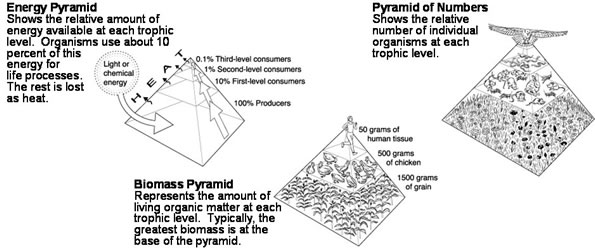
Nurture
Pyramid of security
What do you see? | Nature vs Nurture | Scale | Question | Bernice Abbott | Discussion | Impact | Figure | Landscapes | What we don't see? | illusions
Seeing beyond the surface scale.
Alan Gussow: Artist & Author:
". . . the earth's lovely places. . . . Viewed as a resource that sustains our humanity, the earth is a collection of places."
p. 27.
". . . man is also a place maker – and ultimately a product of the places he himself has known. . . ."
"This is a book about the qualities of certain natural places which certain men and women have responded to with love. Because the men and women were artists, they have left a record of their encounters with the land for others to see, read, and understand. This is really all that sets them apart – that talented connection between eye, mind, and hand. For all of us have our loved places; all of us have laid claim to parts of the earth; and all of us, whether we know it or not, are in some measure the products of our sense of place."
Alan Gussow, A Sense of Place: The Artist and The American Land. (1972). p. 27.
1). One important question for the application of visual learning is not what we are seeing, but how the things we see function and are worth preserving?
2). Are there visual features that without words to stand for them will disappear from our capacity to identify and preserve their character?
As Richard Wilbur, the poet, asks,
"But shall we not soon be forced to recoup, and recover a view of nature which is not purely exploitative?" *
He asks this question and examines a deep sense of loss that he detects in an erosion of our language.
"The common language of rural topography – that vocabulary of dell, swale, coppice and coomb which Hardy used so well – has fallen into disuse , so that we are relatively speechless before the landscape."
Richard Wilbur's warning about our loss of words for natural features.
Dales, dells, and swales seen here within a patchwork of coppice, hillocks, and fields provide viewers with merely the surface impressions of what landscape demands if in dwelling here people are to thrive.
What do you see? | Nature vs Nurture | Scale | Question | Bernice Abbott | Discussion | Impact | Figure | Landscapes | What we don't see? | illusions
Deforestation
The loss of wood in the form of timber harvesting, fire, or charcoal making is an international problems that has so many side-effects that the loss of soil, water and fertility as forests are replaced leaves a countryside perpetually in need of restoration. Wooded areas are required for adequate springs, stream flow, and water table renourishment. Without water the land is unproductive, life atrophies and settlements decline.
What do you see? | Nature vs Nurture | Scale | Question | Bernice Abbott | Discussion | Impact | Figure | Landscapes | What we don't see? | illusions
In this course we ask the same question really in many guises. And, I think, that to get really serious about the matter of what is or is not exploitative you need to ask if visual clues are involved in what you think is exploitative with respect to our surroundings, your experiences and our common landscape.
Richard Wilbur , as an important American poet, comments that:
"we are now obliged to make choices which will reconcile us with a natural system of which we are only a part, and I do not doubt that the process will bring not only a fresh sense of how nature may be used, but also of what it is."
expletive is derived from the word (verb) to exploit, meaning:
- to make use of or use productively to make unethical use of for one's own advantage or gain
- to profit from the labor of another
Place he defines as:
"a place being a fusion of human and natural order, and a peculiar window on the whole."
What do you see? | Nature vs Nurture | Scale | Question | Bernice Abbott | Discussion | Impact | Figure | Landscapes | What we don't see? | illusions
The impact of private farming in the foothills of the Himalayan mountains and the Andes mountains:
Steep hillsides generate erosion and soil loss when cleared.
Himalayan deforestation, Nepal. Andean deforestation, Ecuador. Only at a distance is one able to see the several impacts of each individual clearing of the land for farming as this agricultural practice affects the entire terrain. The terrain depicted here forms part of a watershed that is the source of water falling across the ridge lines and valleys that flows in a single direction from the highest elevation to the lowest area of relief.
The river pictures above comes from below the cleared hillsides in the Andes near Banos, Ecuador and runs grey with the silt and mud washed from the soils cleared for agriculture in addition to boulders and sand.
watersheds | landscape | facts about H2O| water conservation | water
What do you see? | Nature vs Nurture | Scale | Question | Bernice Abbott | Discussion | Impact | Figure | Landscapes | What we don't see? | illusions
Now consider this set of questions:
With these intersections in mind, do you see any shapes in the above design?
What geometrical shapes did you see?
Scenic monumentalism and portraying the sublime.
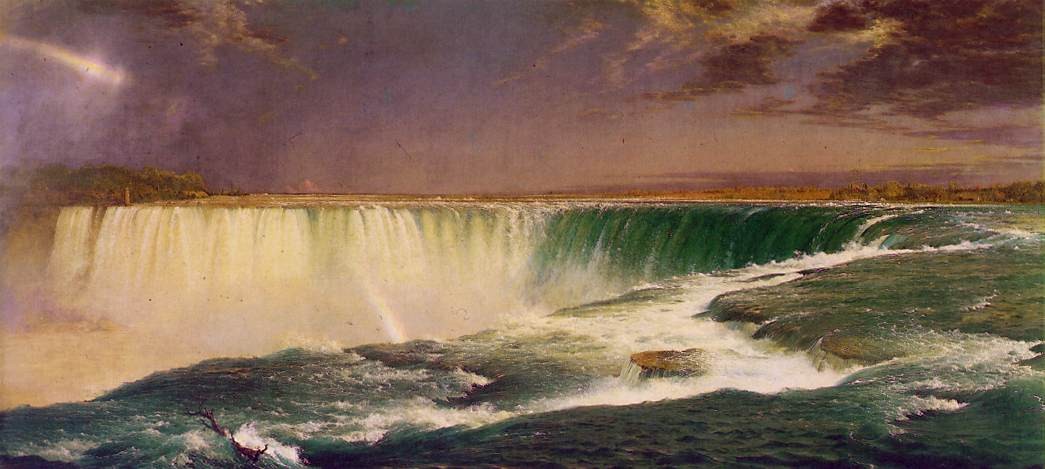
"Niagara" by Frederick Edwin Church, 1857. Oil on canvas. Corcoran Gallery of Art in Washington D. C.
Corcoran Gallery curators explain that:
"The painting was introduced to the American public shortly after its completion, as a one-painting exhibition at the commercial gallery of Williams, Stevens, and Williams in New York City. Art lovers and thrill seekers alike paid 25 cents each to view the monumental canvas [40 x 90 1/2 in.], sometimes using opera glasses or other optical aids to enhance the experience. "
"The price of admission included a pamphlet that reprinted contemporary critics’ praise of Church’s picture and offered exhibition-goers the opportunity to purchase a chromolithograph of the canvas. Within two weeks of its debut, Niagara had lured 100,000 visitors to glimpse what one newspaper critic described as “the finest oil picture ever painted on this side of the Atlantic.” Following its phenomenal success in New York, the painting was exhibited in major cities all along the eastern seaboard, taken on two tours of Britain, and included in the 1867 Exposition Universelle in Paris."Land as a palimpsest of remnants from previous occupation and earlier uses overlain by current uses based on contemporary land-use needs such as electric power from wind, or corn growing for ethanol production.
Land and land-use patterns create visual clues to understand the effects of settlement patterns.
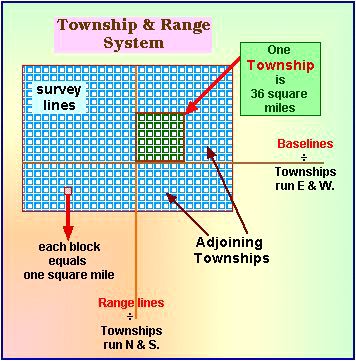
America's Cultural Heritage Landscape Patterns? In these examples describe what you see as a pattern on the land.
Patterns spread across the landscape
What do you see? | Nature vs Nurture | Scale | Question | Bernice Abbott | Discussion | Impact | Figure | Landscapes | What we don't see? | illusions | How to cite art works
Unseen qualities of physical experience:
"staircase" of the material world
Distinguishing between core and peripheral facts can become difficult when the core focus is overwhelmed or obscured by peripheral details. The core of a painting is the focal point of our attention, the background is the peripheral context that supports the subject of the work in traditional painting and photography.
The consequences of a disappearing periphery.
"Critics and the public marveled at the picture’s grand scale, fine detail, and especially its illusion of reality. Unlike his predecessors, Church had eliminated any suggestion of a foreground, allowing the viewer to experience the scene as if precariously positioned on the brink of the falls. As one writer enthusiastically noted, “this is Niagara, with the roar left out!"
Irony, The Irony of American History
Reinhold Niebuhr was an American Theologian after World War Two, he influenced a generation of critical thinkers. A taste of his thought reveals his wisdom transcended the rather juvenile society he lived in that was manifest in terms of widespread vehemently anti-communist intolerance, and race prejudice, while behaving in a commercially materialistic way.
"The mastery of nature is vainly believed to be an adequate substitute for self mastery."
"The sad duty of politics is to establish justice in a sinful world."
"The tendency to claim God as an ally for our partisan value and ends is the source of all religious fanaticism."
Reinhold Niebuhr, faculty, Union Theological Seminary, 1928-1971.
Historian, Arthur Schlesinger Jr. said of him:
"Niebuhr was a critic of national innocence, which he regarded as a delusion. After all, whites coming to these shores were reared in the Calvinist doctrine of sinful humanity, and they killed red men, enslaved black men and later on imported yellow men for peon labor - not much of a background for national innocence. "Nations, as individuals, who are completely innocent in their own esteem," Niebuhr wrote, "are insufferable in their human contacts." The self-righteous delusion of innocence encouraged a kind of Manichaeism dividing the world between good (us) and evil (our critics)."
"Forgetting Reinhold Niebuhr," By ARTHUR SCHLESINGER Jr.
Published: September 18, 2005. New York Times 2005.Terms used
Manichaean perspective, dualism, seeing the world as having only two sides or a dualistic contrast, a view that purports the world is a struggle between conflicting opposites. [ Also, Manichaen.]
incongruity, not in harmony with, out of step with, disharmony, anomaly, or disagreement with something.
annulment, denial, to return to the previous condition without recognizing an effect ever transpired, invalid, or void.
Epistemology the theory of knowledge, especially with regard the methods, validity, and scope of that knowing. Epistemology is the investigation of what distinguishes justified belief from opinion. From the Greek episteme, from epistasthai ‘know, know how to do.’
How do you properly post the source of a work of art?
Consider listing the exact page and the URL of the owner of the work being discussed and post the graphic with a link to the site you used.
A more detailed example is available for you to consider putting this longer description into a footnote. The best example of this is found at: The Matthiesen Gallery, London, U.K.
Artist: Constant Troyon Born, died. Sèvres 1810–1865 Paris Title of work "The Washerwomen" Date 1840 Medium
oil on canvas: 36 1/2 x 55 inches (93 x 140 cm.)comment Signed lower left: C. TROYON Acquired by the Art Institute of Chicago. Catalogue Only owner Where the painting is found: Acquired by The Art Institute, Chicago Owner's description: The Art Institute of Chicago lists the artists with a divergent title of the work: The Marsh, 1840
Oil on canvas
36 1/2 x 55 in. (93 x 140 cm)
Inscribed lower left: C. Troyon
Inscribed on inside of original frame: Mr. Levaigneur 1840.Source: Exhibition The Gallic Prospect: French Artists a collection created in 1999.
PROVENANCE: Mme. Levaigneur, Paris, her sale, Paris, Hôtel Drouot, May 2-4, 1912, no. 19 (as La Mare); with Robert Hellebranth, Paris; anonymous sale, Zürich, Galerie Köller, November 11, 1981, no. 5047; anonymous sale, London, Sotheby's, June 12, 1996, no. 44. Citation: Constant Troyon, The Marsh,1840. Oil on Canvas: Art Institute of Chicago. Commentary by Alexandra Murphy.
"The Washerwomen" [Commentary by Alexandra Murphy.]At the center of The Washerwomen, a massive beech tree rises grand and golden against the sweeping clouds of a a breezy autumn day. That singular tree, and the smaller willow that nestles beside it, provide shelter for a row of bushes on which a local villager spreads her wet laundry, carried up from the pond in the foreground. Less obviously, the immense trees anchor an extraordinary breadth of open countryside that reaches far into the distance to a tiny village identifiable by its minuscule steeple half-hidden among trees. Troyon's tour de force in controlling such an expansive landscape is a tribute to his particular ability to balance a real understanding of the lessons of contemporary English landscape models, particularly John Constable, with careful observation of his native French countryside.
The Washerwomen was probably painted around 1840, when Troyon was working primarily in Brittany or Orléans and was a close friend (as well as sometime-pupil) of Jules Dupré with whom he shared a background as a porcelain painter. Dupré was the only one of the Barbizon artists to actually travel to England and to copy the paintings of Constable, whose leadership in shifting landscape painting away from the classical models of Claude and Poussin toward recognizable native landscapes was much admired in France, even though direct acquaintance with Constable's painting was rare. The recently rediscovered Washerwomen makes very clear that Troyon, too, was an admirer of Constable's art and unusually adept at translating Constable's achievement into French. The commonplace working site that Troyon has chosen for The Washerwomen, the scale and openness he has mastered in this large landscape, and the successful incorporation of a broad, high-keyed sky are all acknowledgements of modern English reworking of the conventions of Dutch seventeenth-century landscape painting. At the same time, the variety of human incident from the villager women and their children in the foreground to the tiny figures beneath the trees along the right and or crossing the fields deep in the middle ground is very characteristic of Troyon who continually strove to make his modern landscapes intelligible as well as appealing to a large audience. And the distinctive thick impasto that is manipulated throughout the foreground in the rocks, the rising ground along the left, and the central trees is also more typical of French painting than English -- although on occasion it was precisely Troyon's emphatic paint textures that most startled and offended conservative Salon critics.
Alexandra Murphy
Acquired by the Art Institute of Chicago
Matthiesen Gallery & Stair Sainty Matthiesen , 'The Gallic Prospect', 1999Kemp, Visualizations, . p. 106.
Gregory Bateson, Mind and Nature.
Richard Wilbur, "Introduction," A Sense of Place: The Artist and the American Land.(1971), p. 26,
Alan Gussow, A Sense of Place: The Artist and the American Land. (1971), pp. 27-28.Childe Hassam, American, 1859–1935: Boston Common at Twilight, 1885–86. Oil on canvas. Gift of Miss Maud E. Appleton. Boston Museum of FIne Arts.
Alfred Stieglitz, (American, Hoboken, New Jersey 1864–1946 New York): Winter - Fifth Avenue, Photogravure. Date: 1893, printed 1905. Metropolitan Museum of Art, New York City.
The painter wears clothes popular in the period when Spain ruled the Netherlands. Why?
"On the wall, a geographical map by Nicholas Piscator, a great Dutch geographer and chronicler of the 1620s, representing the Netherlands.
The typically Dutch, very beautiful brass or bronze candelabra does not contain a single candle.
The scene opens up. The curtain is drawn. This is a tapestry from the beginning of the 16th century, crafted in Spain.
According to some historians, this strange painting may have some political significance. The painter's clothes, dating from the 1530s, when Holland was under Spanish rule and the sumptuous and colorful tapestry could represent nostalgia for the culture, the taste for the arts and Spanish patronage, led by the Duke of Alba. He was a dreadful politician, but a man who upheld the arts with all his strength and fervor. The famous Thirty Year's War allowed the Dutch to rid themselves of Spanish rule."
Answers
A a small right triangle pointing down the page
B a large right triangle resting on its short base
X a hexagon, or six even-sided figure
What do you see? | Nature vs Nurture | Scale | Question | Bernice Abbott | Discussion | Impact | Figure | Landscapes | What we don't see? | illusions | How to cite art works